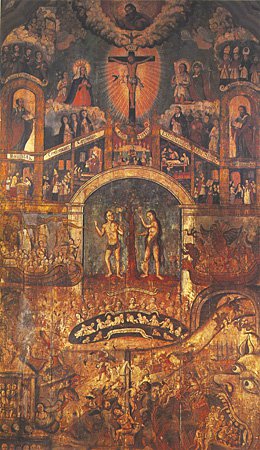Cultural Center of the Philippines
ENCYCLOPEDIA OF
PHILIPPINE ART
[El Cielo, El Paraiso, El Purgatorio y El Infierno]
(Heaven, Paradise, Purgatory, and Hell) / 1850 / Oil on vertical wood planks / 500 x 350 cm / Artist: Attributed to Jose Dans / Roman Catholic Parish Church of Santiago, Paete, Laguna
Multizonal in composition, this mural helps introduce the Roman Catholic cosmogony to its viewers. The painting’s vertical space is expediently divided into four sections. Shown in the topmost section is Heaven; below it is Earth, represented by vignettes of the Seven Sacraments. Under Earth, occupying the center of the painting, are Adam and Eve standing beside the Tree of Knowledge. Flanking this central image and directly below it are three scenes representing Purgatory. Below Purgatory is Hell in all its terrors.
As a catechetical painting, the mural portrays the most important personages of Heaven and Hell. At the center of the heavenly plane is Christ crucified; above him, the Holy Spirit in the form of a dove; and above the dove, God the Father represented as an ancient-looking man. Christ is flanked on both sides by the Blessed Virgin on his right and San Juan Bautista and San Jose on the left. The vignettes illustrating the Seven Sacraments that feature folk in native costumes stress that only through compliance or fulfillment of these vital practices of the church can the faithful find eternal salvation.
The lower half of the painting contains the scenes with the most popular appeal; here depicted are the first love story, that of Adam and Eve, and also nerve-gripping spectacles like the suffering of the souls in Purgatory and the punishments of Hell. The boats of the forgiven and that of the damned flank the Paradise scene. The images of Hell’s mouth, sinners trapped in cages, as well as condemned souls in various forms of torture, give evidence to the artist’s engraving inspiration. The artist copied his subject from Greek mythology. Dans, however, seems to have also included images from Philippine netherworld folklore, like the kapre or ogre; tikbalang or half-human, half-horse; aswang or malevolent being; and maligno or evil spirit.
Dans was essentially a folk artist. He was mainly driven to narrate the compelling details of his subject as a storyteller and was less preoccupied with pictorial skills to obtain a naturalistic presentation. As in a cartoon, crisply etched lines rendered the contour of his figures while hues in their full intensity helped enliven this charming visual narrative.
Written by Santiago A. Pilar
